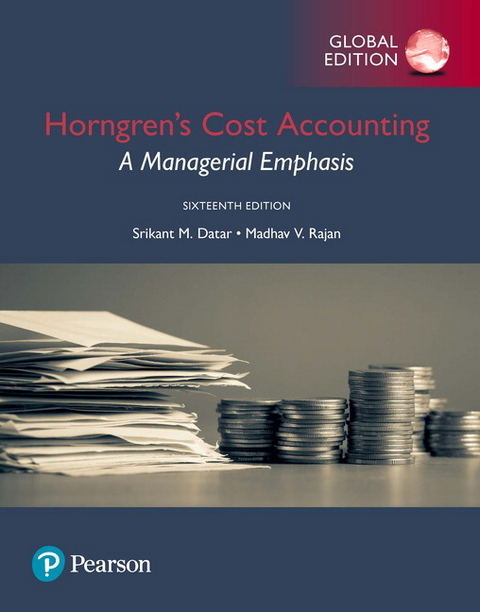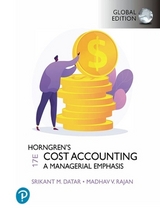
Horngren's Cost Accounting: A Managerial Emphasis, Global Edition
Pearson Education Limited (Verlag)
978-1-292-21154-1 (ISBN)
- Titel erscheint in neuer Auflage
- Artikel merken
* Emphasis on sustainability as one of the critical managerial challenges of the coming decades, including: * Material that stress themes of recognizing and accounting for environmental costs, energy independence and the smart grid, setting stretch targets to motivate greater carbon reductions, using cost analysis, carbon tax, and cap-and-trade auctions to reduce environmental footprints, and constructing "green" homes in a cost-effective manner. * More focus on the role of accounting concepts and systems in fostering and supporting innovation and entrepreneurial activities in firms including: * The challenges posed by recognizing R&D costs as period expenses even though the benefits of innovation accrue in later periods. * How companies budget for innovation expenses and develop measures to monitor success of the innovation efforts delinked from operational performance in the current period (Chapter 6). * The importance of nonfinancial measures when making decisions about innovation (Chapter 11). * The concept that innovation starts with understanding customer needs (Chapter 13). * Process innovations for improving quality (Chapter 19).
* Cutting-edge topics are covered, including: * Material around recent trends in big data and data analytics in predicting costs and when making demand forecasts. Provide a solid presentation of accounting hallmarks with a great emphasis on strategy * Strategy maps are presented as a useful tool to implement the balanced scorecard and a simplified presentation of how income statements of companies can be analyzed from the strategic perspective of product differentiation or cost leadership. A new section helps students evaluate strategy maps such as the strength of links, differentiators, focal points and trigger points. * Try It examples are simple and focus on key ideas or concepts. They are located after a particular concept or calculation, and invite students to practice what they have just learned. * Becker Multiple Choice Questions in the assignment material probe students' knowledge of the chapter material and their ability to think critically about key concepts. * Opening Vignettes. Each chapter opens with a vignette on a real company situation.
The vignettes get students engaged in a business situation, or dilemma, illustrating why and how the concepts in the chapter are relevant in business. New examples on Quiksilver, General Motors, Boeing, Delta, Honda, and Viacom have been incorporated. * Concepts in Action Boxes. Found in every chapter, these boxes cover real-world cost accounting issues across a variety of industries including automobile racing, defense contracting, entertainment, manufacturing, and retailing. New examples include Subway, Chipotle, H&M, Amazon, Under Armour, and Netflix.
Srikant M. Datar is the Arthur Lowes Dickinson Professor of Business Administration at the Harvard Business School, Faculty Chair of the Harvard University Innovation Labs, and Senior Associate Dean for University Affairs. He previously served as Senior Associate Dean from 2000 to 2010. A graduate with distinction from the University of Bombay, he received gold medals upon graduation from the Indian Institute of Management, Ahmedabad, and the Institute of Cost and Works Accountants of India. A chartered accountant, he holds two master’s degrees and a PhD from Stanford University. Madhav V. Rajan is the Robert K. Jaedicke Professor of Accounting at Stanford University’s Graduate School of Business. He is also Professor of Law (by courtesy) at Stanford Law School. From 2010 to 2016, he was Senior Associate Dean for Academic Affairs and head of the MBA program at the Stanford GSB.
1. The Manager and Management Accounting
2. An Introduction to Cost Terms and Purposes
3. Cost–Volume–Profit Analysis
4. Job Costing
5. Activity-Based Costing and Activity-Based Management
6. Master Budget and Responsibility Accounting
7. Flexible Budgets, Direct-Cost Variances, and Management Control
8. Flexible Budgets, Overhead Cost Variances, and Management Control
9. Inventory Costing and Capacity Analysis
10. Determining How Costs Behave
11. Decision Making and Relevant Information
12. Strategy, Balanced Scorecard, and Strategic Profitability Analysis
13. Pricing Decisions and Cost Management
14. Cost Allocation, Customer-Profitability Analysis, and Sales-Variance Analysis
15. Allocation of Support-Department Costs, Common Costs, and Revenues
16. Cost Allocation: Joint Products and Byproducts
17. Process Costing
18. Spoilage, Rework, and Scrap
19. Balanced Scorecard: Quality and Time
20. Inventory Management, Just-in-Time, and Simplified Costing Methods
21. Capital Budgeting and Cost Analysis
22. Management Control Systems, Transfer Pricing, and Multinational Considerations
23. Performance Measurement, Compensation, and Multinational
| Erscheinungsdatum | 09.06.2017 |
|---|---|
| Verlagsort | Harlow |
| Sprache | englisch |
| Maße | 215 x 275 mm |
| Gewicht | 1914 g |
| Themenwelt | Sachbuch/Ratgeber ► Beruf / Finanzen / Recht / Wirtschaft ► Wirtschaft |
| Schulbuch / Wörterbuch | |
| Wirtschaft ► Betriebswirtschaft / Management ► Controlling / Kostenrechnung | |
| ISBN-10 | 1-292-21154-7 / 1292211547 |
| ISBN-13 | 978-1-292-21154-1 / 9781292211541 |
| Zustand | Neuware |
| Haben Sie eine Frage zum Produkt? |
aus dem Bereich



